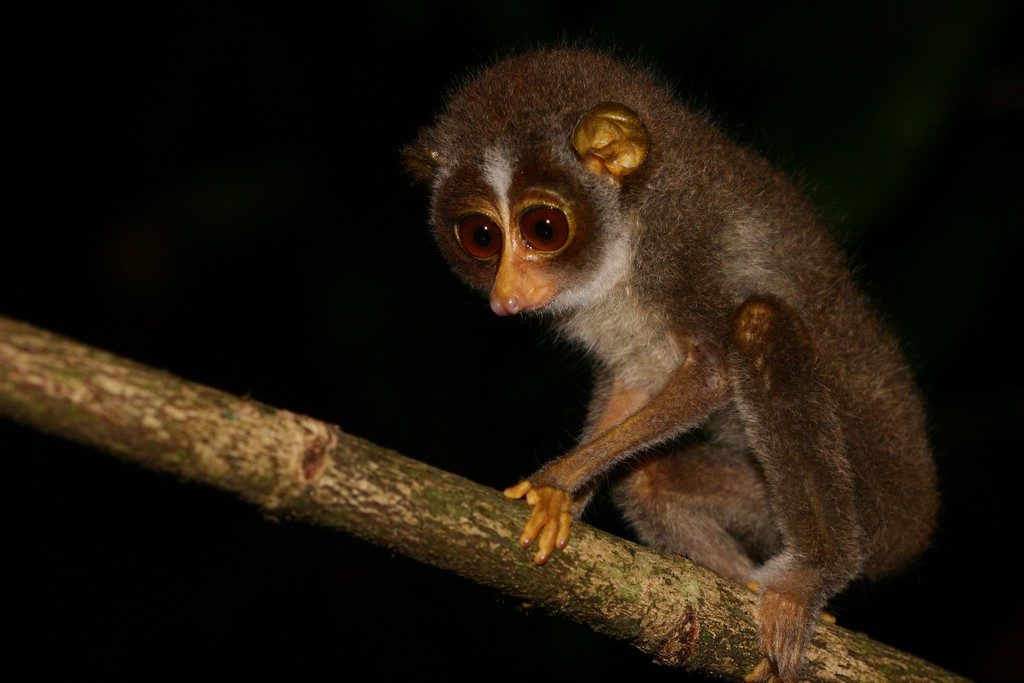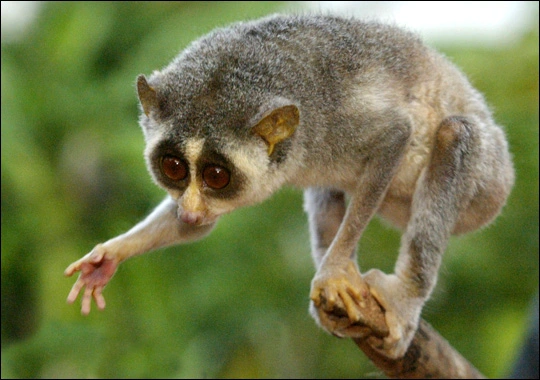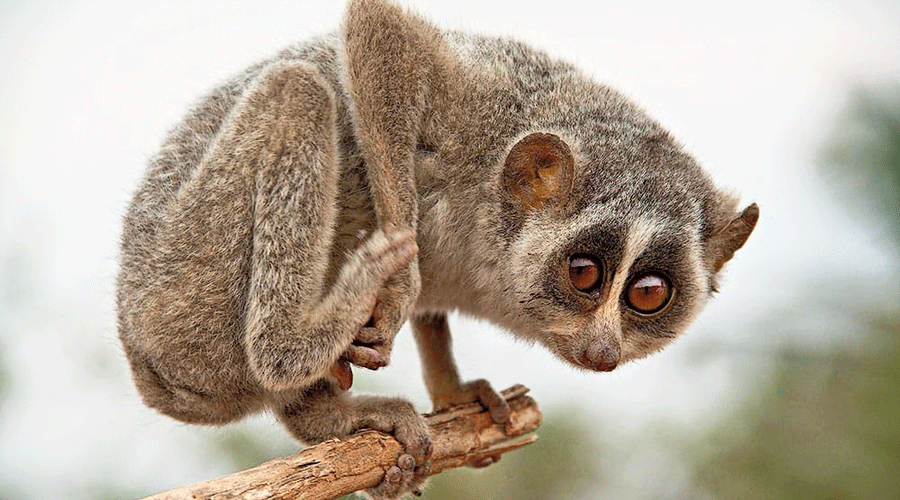The slender lorises (Thevangu) (Loris) are a genus of loris native to India and Sri Lanka.
The genus comprises two species,
- The red slender loris found in Sri Lanka
- The gray slender loris from Sri Lanka and India.
Slender lorises (Thevangu) spend most of their life in trees, traveling along the tops of branches with slow and precise movements. They are found in tropical rainforests, scrub forests, semi-deciduous forests, and swamps.
The primates have lifespans of approximately 15 years and are nocturnal. Slender lorises generally feed on insects, reptiles, plant shoots, and fruit.

The two subspecies of red slender loris (Thevangu) differ in their habitat preference, the lowland loris, L. t. tardigradus, favors wet lowland forests (up to 470 m above sea level) south western wet-zone of Sri Lanka while the mountain loris, L. t. nycticeboides, prefers cloud, montane, and highland evergreen forests at elevations of 1800–2300 m. The gray slender loris can be found in tropical rainforests, primary and some secondary, coastal acacia scrub forests, semi-evergreen forests, swamps, and bamboo groves up to 2000 m above sea level.
Name Reason
The type species was named Lemur tardigradus by Linnaeus in 1758. The name Loris is first reported Georges-Louis Leclerc, Comte de Buffon in 1765, representing the Dutch loeris meaning “clown”. According to Buffon, the name loeris had been in use for some time by Dutch naturalists for the “sloths of Ceylon”.

The genus Loris was separated from lemurs by Étienne Geoffroy Saint-Hilaire (1796), based on a suggestion of a Lorican genus by Louis-Jean-Marie Daubenton (1792). Saint-Hilaire’s Loris at first included Daubenton’s type species, Loris de Buffon, which he however delegated to the new Nycticebus genus in 1812.
In India, slender lorises are known as devanga-pilli (దేవాంగ పిల్లి) or arawe-papa in Telugu, kaadu-paapa (ಕಾಡು ಪಾಪ) in Kannada, Kaada Naramani (ಕಾಡ ನರಮನಿ) in Tulu and wanur-manushiya in Marathi.
In Sri Lanka they are known as unahapuluwa (උනහපුළුවා) in Sinhala, in Tamil, spoken across southern India and Sri Lanka and in Malayalam, spoken mainly in the Indian state of Kerala, they are known as kutti thevangu (in Tamil தேவாங்கு, வா(வாக்கு) விலங்கு(ங்கு)) (kattu-papa, Kadapapa, or theivangu (meaning ‘the slender-bodied one’) and in Malayalam കുട്ടിതേവാങ്ക്).
Female slender lorises (Thevangu) generally have an exclusive home range while males may overlap with others. They often form small social groups to sleep, containing adults of both sexes as well as the young. The groups also undertake mutual grooming and play wrestling. The adults typically hunt separately during the night. Males will follow females while they are in oestrus and mating may occur after a bout of play fighting. Gray slender lorises will often bear twins but the survival rate is low. Newborn infants cling to the mother’s front for a few weeks and after that will be “parked” in a tree while the mother goes off to feed.
According to biologists, poaching activity has led to the steady decline of the species in Tamil Nadu. Native people have always believed that all parts of the slender loris (Thevangu) have some medicinal or magical powers. This has contributed greatly to the decline of the slender loris. In addition, slender lorises are illegally smuggled to supply a growing exotic pet trade. Other threats include habitat loss, electrocution on live wires, and road accidents. Along the western region of Tamil Nadu, there is a vigorous clampdown on illegal poaching of slender lorises.
Destruction of tropical rain forest habitat is also contributing to declines in population.
IUCN has listed them as Endangered, whereas they are listed under the Schedule I of the Wildlife (Protection) Act of India, 1972, according them the highest level of legal protection. WWF-India is working to protect the habitats of the Slender Loris through its wider conservation work in the Western Ghats – Nilgiris Landscape.
Interesting Fact 1:
The Slender Loris (Thevangu) has a unique defense mechanism that is unlike most other primates. When threatened, the Slender Loris will freeze in place and remain completely still, almost as if it has turned to stone. This is known as ‘cryptic behavior’ and allows the Slender Loris to blend in with its surroundings and avoid detection by predators. This behavior can last for several hours, and if the predator does not leave, the Slender Loris may emit a loud, piercing scream to startle the predator and make its escape.
Interesting Fact 2:
The Slender Loris (Thevangu) is known for its unique grooming habits. Unlike most primates, the Slender Loris will use its lower incisor teeth to clean its fur and remove any parasites or debris. It also has a specialized grooming claw on its second toe that it uses to scratch and groom hard-to-reach areas of its body. This behavior is not only important for maintaining good hygiene, but it also helps to strengthen social bonds between members of the same species.
Interesting Fact 3:
The Slender Loris (Thevangu) is a nocturnal animal that is most active at night. During the day, it will typically rest in tree hollows or curled up in a ball on a branch. To avoid predators, the Slender Loris will freeze and remain motionless if it senses danger. It will also use its large eyes to scan the environment for potential threats.
Interesting Fact 4:
Slender Lorises (Thevangu) have a unique way of communicating with each other through a complex system of vocalizations. They make a range of sounds, including soft clicking noises and high-pitched calls. Researchers believe that the different vocalizations are used to communicate different messages, such as warning others of predators, attracting mates, or indicating territorial boundaries.
Interesting Fact 5:
Slender Lorises (Thevangu) have a specialized tongue that is covered in tiny spines, which helps them to lap up nectar from flowers. They are important pollinators for many species of plants, particularly in their native habitats of India and Sri Lanka. The spines on their tongue also help them to groom themselves and remove parasites from their fur.
Slender Lorises (Thevangu) are also known for their slow movements and unique way of walking, which is called “stiff-legged arboreal quadrupedalism”. This means that they move along tree branches by extending their arms and legs and moving in a slow and deliberate manner. They are well adapted to life in the trees and are able to cling to vertical surfaces with their strong hands and feet.
